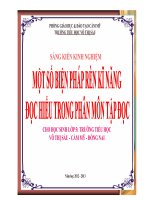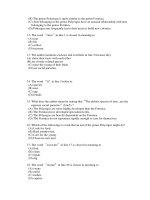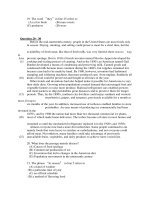kí năng đọc hiểu trong toeic 6 pot
Bạn đang xem bản rút gọn của tài liệu. Xem và tải ngay bản đầy đủ của tài liệu tại đây (64.27 KB, 6 trang )
19. The word “they”in line 25 refers to
(A) a few birds (B) mass roosts
(C) predators (D) trees
Question 20 - 30
Before the mid-nineteenth century, people in the United States ate most foods only
in season. Drying, smoking, and salting could preserve meat for a short time, but the
availability of fresh meat, like that of fresh milk, was very limited; there was no way
to
Line prevent spoilage. But in 1810 a French inventor named Nicolas Appert developed the
(5) cooking-and-sealing process of canning. And in the 1850's an American named Gail
Borden developed a means of condensing and preserving milk. Canned goods and
condensed milk became more common during the 1860's, but supplies remained low
because cans had to be made by hand. By 1880, however, inventors had fashioned
stamping and soldering machines that mass-produced cans from tinplate. Suddenly all
(10) kinds of food could be preserved and bought at all times of the year.
Other trends and inventions had also helped make it possible for Americans to vary
their daily diets. Growing urban populations created demand that encouraged fruit and
vegetable farmers to raise more produce. Railroad refrigerator cars enabled growers
and meat packers to ship perishables great distances and to preserve them for longer
(15) periods. Thus, by the 1890's, northern city dwellers could enjoy southern and western
strawberries, grapes, and tomatoes, previously available for a month at
most, for up to
six months of the year. In addition, increased use of iceboxes enabled families to store
perishables. An easy means of producing ice commercially had been
invented in the
1870's, and by 1900 the nation had more than two thousand commercial ice plants,
(20) most of which made home deliveries. The icebox became a fixture in most homes and
remained so until the mechanized refrigerator replaced it in the 1920's and 1930's.
Almost everyone now had a more diversified diet. Some people continued to eat
mainly foods that were heavy in starches or carbohydrates, and not everyone could
afford meat. Nevertheless, many families could take advantage of previously
(25) unavailable fruits, vegetables, and dairy products to achieve more varied fare.
20. What does the passage mainly discuss?
(A) Causes of food spoilage
(B) Commercial production of ice
(C) Inventions that led to changes in the American diet
(D) Population movements in the nineteenth century
21. The phrase “in season” in line 2 refers to
(A) a kind of weather
(B) a particular time of year
(C) an official schedule
(D) a method of flavoring food
22. The word “prevent” in line 4 is closest in meaning to
(A) estimate
(B) avoid
(C) correct
(D) confine
23. During the 1860's, canned food products were
(A) unavailable in rural areas
(B) shipped in refrigerator cars
(C) available in limited quantities
(D) a staple part of the American diet
24. It can be inferred that railroad refrigerator cars came into use
(A) before 1860
(B) before 1890
(C) after 1900
(D) after 1920
25. The word “them ” in line 14 refers to
(A) refrigerator cars
(B) perishables
(C) growers
(D) distances
26. The word “fixture” in line 20 is closest in meaning to
(A) luxury item
(B) substance
(C) commonplace object
(D) mechanical device
27. The author implies that in the 1920's and 1930's home deliveries of ice
(A) decreased in number
(B) were on an irregular schedule
(C) increased in cost
(D) occurred only in the summer
28. The word “Nevertheless” in line 24 is closest in meaning to
(A) therefore
(B) because
(C) occasionally
(D) however
29. Which of the following types of food preservation was NOT mentioned in the
passage?
(A) Drying
(B) Canning
(C) Cold storage
(D) Chemical additives
30. Which of the following statements is supported by the passage?
(A) Tin cans and iceboxes helped to make many foods more widely available.
(B) Commercial ice factories were developed by railroad owners.
(C) Most farmers in the United States raised only fruits and vegetables.
(D) People who lived in cities demanded home delivery of foods.
Question 31 - 38
The ability of falling cats to right themselves in midair and land on their feet has
been a source of wonder for ages. Biologists long regarded it as an example of
adaptation by natural selection, but for physicists it bordered on the miraculous.
Line Newton's laws of motion assume that the total amount of spin of a body cannot change
(5) unless an external torque speeds it up or slows it down. If a cat has no spin when it is
released and experiences no external torque, it ought not to be able to twist around as it
falls.
In the speed of its execution, the righting of a tumbling cat resembles a magician's
trick. The gyrations of the cat in midair are too fast for the human eye to follow, so the
(10) process is obscured. Either the eye must be speeded up, or the cat's fall slowed down
for the phenomenon to be observed. A century ago the former was accomplished by
means of high-speed photography using equipment now available in any pharmacy.
But in the nineteenth century the capture on film of a falling cat constituted a scientific
experiment.
(15) The experiment was described in a paper presented to the Paris Academy in 1894.
Two sequences of twenty photographs each, one from the side and one from behind,
show a white cat in the act of righting itself. Grainy and quaint though they are, the
photos show that the cat was dropped upside down, with no initial spin, and still landed
on its feet. Careful analysis of the photos reveals the secret ; As the cat rotates the front
(20) of its body clockwise, the rear and tail twist counterclockwise, so that the total spin
remains zero, in perfect accord with Newton's laws. Halfway down, the cat pulls in its
legs before reversing its twist and then extends them again, with the desired end result.
The explanation was that while no body can acquire spin without torque, a flexible one
can readily change its orientation, or phase. Cats know this instinctively, but scientists
(25) could not be sure how it happened until they increased the speed of their perceptions a
thousandfold.
31. What does the passage mainly discuss?
(A) The explanation of an interesting phenomenon
(B) Miracles in modern science
(C) Procedures in scientific investigation
(D) The differences between biology and physics
32. The word “process”in line 10 refers to
(A) the righting of a tumbling cat
(B) the cat's fall slowed down
(C) high-speed photography
(D) a scientific experiment
33. Why are the photographs mentioned in line 16 referred to as an “experiment”?
(A) The photographs were not very clear.
(B) The purpose of the photographs was to explain the process.
(C) The photographer used inferior equipment.
(D) The photographer thought the cat might be injured.
34. Which of the following can be inferred about high-speed photography in
the late 1800's ?
(A) It was a relatively new technology.
(B) The necessary equipment was easy to obtain.
(C) The resulting photographs are difficult to interpret.
(D) It was not fast enough to provide new information.
35. The word “rotates” in line 19 is closest in meaning to
(A) drops
(B) turns
(C) controls
(D) touches
36. According to the passage, a cat is able to right itself in midair because it is
(A) frightened
(B) small
(C) intelligent
(D) flexible
37. The word “readily”in line 24 is closest in meaning to
(A) only
(B) easily
(C) slowly
(D) certainly
38. How did scientists increase “the speed of their perceptions a
thousandfold”(lines 25-26)?
(A) By analyzing photographs
(B) By observing a white cat in a dark room
(C) By dropping a cat from a greater height
(D) By studying Newton's laws of motion
Question 39 - 50
The changing profile of a city in the United States is apparent in the shifting
definitions used by the United States Bureau of the Census. In 1870 the census
officially distinguished the nation's “urban” from its “rural” population for the first
Line time. “Urban population” was defined as persons living in towns of 8,000 inhabitants
(5) or more. But after 1900 it meant persons living in incorporated places having 2,500 or
more inhabitants.
Then, in 1950 the Census Bureau radically changed its definition of “urban” to take
account of the new vagueness of city boundaries. In addition to persons living in
incorporated units of 2,500 or more, the census now included those who lived in
(10) unincorporated units of that size, and also all persons living in the densely settled urban
fringe, including both incorporated and unincorporated areas located around cities of
50,000 inhabitants or more. Each such unit, conceived as an integrated economic and
social unit with a large population nucleus, was named a Standard Metropolitan
Statistical Area (SMSA).
(15) Each SMSA would contain at least (a) one central city with 50,000 inhabitants or
more or (b) two cities having shared boundaries and constituting, for general economic
and social purposes, a single community with a combined population of at least 50,000,
the smaller of which must have a population of at least 15,000. Such an area included
the county in which the central city is located, and adjacent counties that are found to
(20) be metropolitan in character and economically and socially integrated with the county
of the central city. By 1970, about two-thirds of the population of the United States was
living in these urbanized areas, and of that figure more than half were living outside the
central cities.
While the Census Bureau and the United States government used the term SMSA
(25) (by 1969 there were 233 of them), social scientists were also using new terms to
describe the elusive, vaguely defined areas reaching out from what used to be simple
“towns” and “cities”. A host of terms came into use : “metropolitan
regions,”
“polynucleated population groups,” “conurbations,” “metropolitan clusters,”
“megalopolises,” and so on.
39. What does the passage mainly discuss?
(A) How cities in the United States began and developed
(B) Solutions to overcrowding in cities
(C) The changing definition of an urban area
(D) How the United States Census Bureau conducts a census
40. According to the passage, the population of the United States was
first classified as rural or urban in
(A) 1870
(B) 1900
(C) 1950
(D) 1970
41. The word “distinguished”in line 3 is closest in meaning to
(A) differentiated (B) removed
(C) honored (D) protected
42. Prior to 1900, how many inhabitants would a town have to have before being
defined as urban?
(A) 2,500
(B) 8,000
(C) 15,000
(D) 50,000
43. According to the passage, why did the Census Bureau revise the definition
of urban in 1950?
(A) City borders had become less distinct.
(B) Cities had undergone radical social change.
(C) Elected officials could not agree on an acceptable definition.
(D) New businesses had relocated to larger cities.
44. The word “those”in line 9 refers to
(A) boundaries
(B) persons
(C) units
(D) areas
45. The word “constituting” in line 16 is closest in meaning to
(A) located near
(B) determined by
(C) calling for
(D) making up
46. The word “which ” in line 18 refers to a smaller









